
Exposé Online
What's old
Exposé print issues (1993-2011)
- 1 (October 1993)
- 2 (February 1994)
- 3 (May 1994)
- 4 (August 1994)
- 5 (October 1994)
- 6 (March 1995)
- 7 (July 1995)
- 8 (November 1995)
- 9 (March 1996)
- 10 (August 1996)
- 11 (February 1997)
- 12 (May 1997)
- 13 (October 1997)
- 14 (February 1998)
- 15 (July 1998)
- 16 (January 1999)
- 17 (April 1999)
- 18 (November 1999)
- 19 (May 2000)
- 20 (October 2000)
- 21 (March 2001)
- 22 (July 2001)
- 23 (December 2001)
- 24 (April 2002)
- 25 (September 2002)
- 26 (February 2003)
- 27 (August 2003)
- 28 (December 2003)
- 29 (April 2004)
- 30 (September 2004)
- 31 (March 2005)
- 32 (September 2005)
- 33 (May 2006)
- 34 (March 2007)
- 35 (January 2008)
- 36 (October 2008)
- 37 (July 2009)
- 38 (July 2010)
- 39 (Summer 2011)
Reviews
Heretic / Hiro Kawahara — Complete Works
(Cuneiform Rune 3382, 2023, DL)
by Peter Thelen, Published 2023-08-23
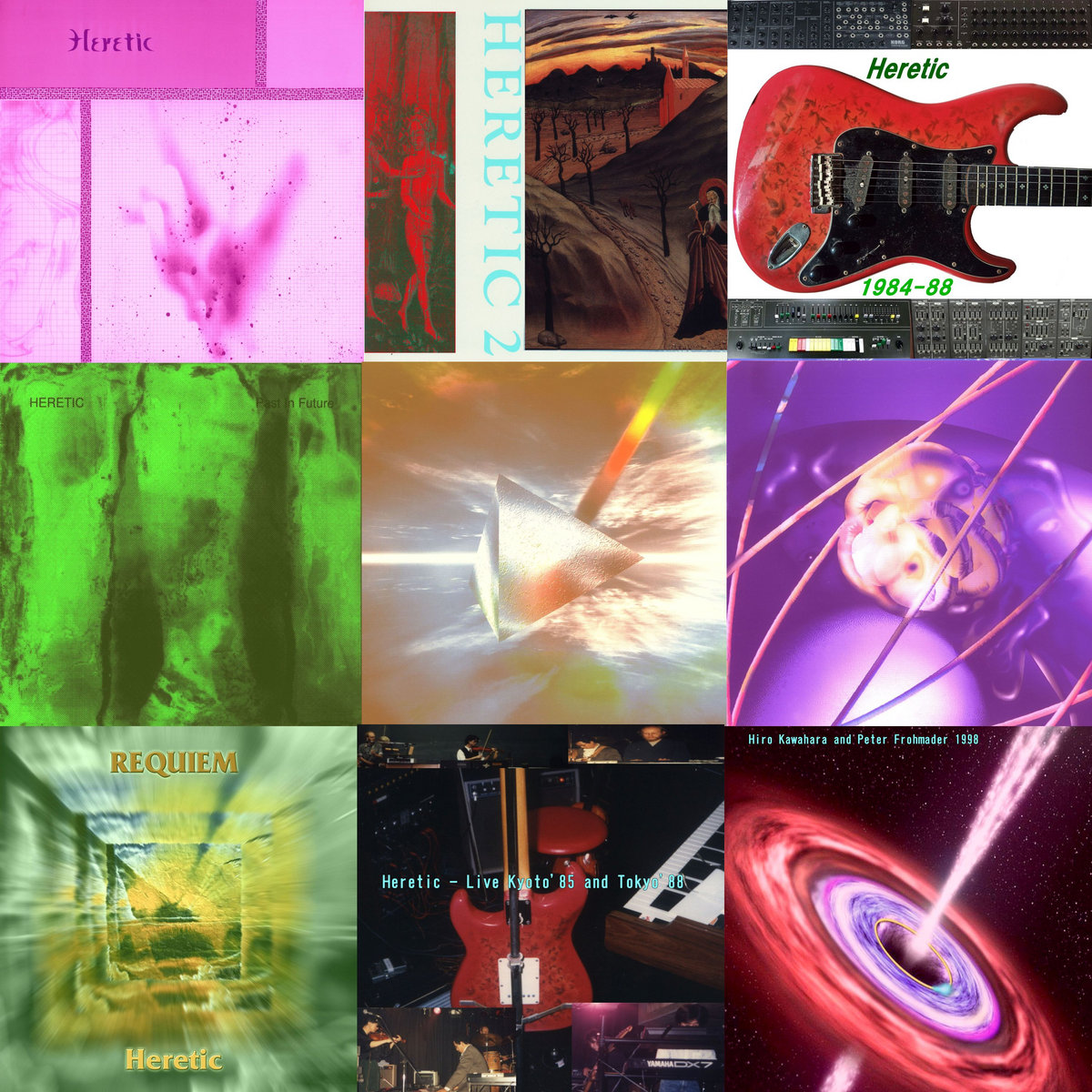
Some of the best kept secrets of the Japanese progressive music scene were the bands and projects of Hirofumi Kawahara — Osiris, Astral Tempel, and Heretic — probably because they didn’t fit into any of the convenient styles like symphonic progressive or the avant progressive that followed shortly after. Not that any of it became well known outside of Japan, but Kawahara’s projects were even slower to catch on, although Archie Patterson did his best to promote it to the wider world. Now after 44 years of musical activity, Kawahara’s entire body of work (to date) is being released in digital format as Heretic / Hiro Kawahara – Complete Works by Cuneiform, nine works in all, but don’t think of these as nine CDs, because while several correspond to earlier released LPs and CDs, most are packed with bonus material well beyond the capacity limits of either of those physical media, over thirteen and a half hours of music. Each of the nine works can be purchased seperately as well, something Cuneiform tried with the Muffins set Baker’s Dozen which apparently worked out because they are doing it that way again.
The first component of this set includes the first Heretic album Interface, originally released in a private LP pressing of a couple hundred copies. The main title track is close to 35 minutes long, originally spread across all of side one and the first half of side two, the two parts are now joined together. If the title conjures up thoughts of Heldon, that’s probably intentional — the heady stew of electronics, synthesizers, guitars, and percussion, all played by Tohru Ohta and Hiro Kawahara, with Takorou Moriyama on cello and guest players on organ and synth, is occasionally similar to Heldon but often wanders into symphonic territories, punctuated with bold melodic statements and strong experimental leanings. The piece goes through a number of wildly different sections, each with is own mood and character, some using unusual sampled tape sounds, wandering between stark beauty and total chaos and all points in between. The original album was rounded out by the roughly twelve minute “El Rayo de Luna” at the end of side two, a more dark and somber piece with swaths of melodic cello and femaie voice (guest Akiko Yuki) fading in and out of the mix at various points. Bonus tracks include two shorter alternate versions of “Interface” — a thirteen minute ‘symphonic’ version, and a twelve minute rehearsal version from August 24, 1984. The original sepia-toned cover is now replaced with a pink version of the same image.
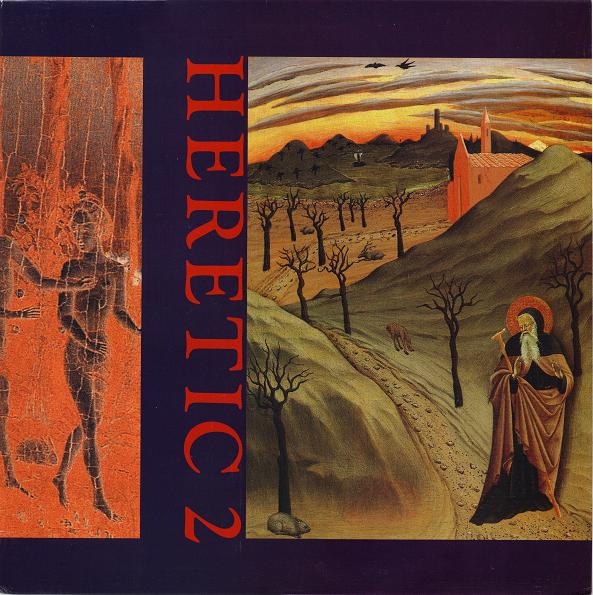 The second Heretic LP, released in 1988, is Escape Sequence, originally released on the Belle Antique label. This featured a larger lineup (Ohta, Kawahara, and Moriyama) with Robbin Lloyd joining the group on drums and syn-bass on a couple tracks, and Mianako Urasawa supplies voice on three tracks, plus a much longer roster of guests: two members of Ain Soph (Yozox, guitar on one track, and Taiqui Tomiiye, drums and electronic percussion on two other cuts), and two members of the band Anonymous appear on the track simply titled “Anonymous,” plus several others. The centerpiece of Escape Sequence is the near-22-minute three part epic “Do Heretick” that occupies the entire first side of the LP. The opening section “Create” employs some fairly experimental techniques with guitars, synths, percussion, and found sounds wandering in and out of the mix as it proceeds; the second section “Modify Structure” is a wild cornucopia of rapidly accelerating electronic sequences that eventually devolves into another experimental fantasy spruced up by some wild guitar soloing, which leads into the final section “Quit” with a “Mars the Bringer of War” style march, with a chaotic stew of voices and electronic sounds in play around the Frippian guitars. The second half launches with a remixed version of “Fail Safe Error,” coming in a few minutes shorter than the original (sans the spoken sequence from the 1964 cold war thriller Fail Safe with Henry Fonda), though no less intense, with all the blistering screaming guitar action. At only four minutes and change, the aforementioned “Anonymous” is a dark, moody King Crimson-like piece that slowly fades into the jangly electronic cadence of “Tripping on Waves,” with mysterious spoken voices in the background and punchy guitar solos taking it up to the next level, leading to the beautifully gentle original album closer “m-a-f-o-r-o-b-a.” Three alternate versions of “Do Heretick” are included as bonus tracks: a five minute ‘sound idea’ from October 1987, a “Do Heretic Session” with Taiqui Tomiiye from a week later, and the “Do Hereick” original version from 1985 that clocks in at almost 39 minutes!
The second Heretic LP, released in 1988, is Escape Sequence, originally released on the Belle Antique label. This featured a larger lineup (Ohta, Kawahara, and Moriyama) with Robbin Lloyd joining the group on drums and syn-bass on a couple tracks, and Mianako Urasawa supplies voice on three tracks, plus a much longer roster of guests: two members of Ain Soph (Yozox, guitar on one track, and Taiqui Tomiiye, drums and electronic percussion on two other cuts), and two members of the band Anonymous appear on the track simply titled “Anonymous,” plus several others. The centerpiece of Escape Sequence is the near-22-minute three part epic “Do Heretick” that occupies the entire first side of the LP. The opening section “Create” employs some fairly experimental techniques with guitars, synths, percussion, and found sounds wandering in and out of the mix as it proceeds; the second section “Modify Structure” is a wild cornucopia of rapidly accelerating electronic sequences that eventually devolves into another experimental fantasy spruced up by some wild guitar soloing, which leads into the final section “Quit” with a “Mars the Bringer of War” style march, with a chaotic stew of voices and electronic sounds in play around the Frippian guitars. The second half launches with a remixed version of “Fail Safe Error,” coming in a few minutes shorter than the original (sans the spoken sequence from the 1964 cold war thriller Fail Safe with Henry Fonda), though no less intense, with all the blistering screaming guitar action. At only four minutes and change, the aforementioned “Anonymous” is a dark, moody King Crimson-like piece that slowly fades into the jangly electronic cadence of “Tripping on Waves,” with mysterious spoken voices in the background and punchy guitar solos taking it up to the next level, leading to the beautifully gentle original album closer “m-a-f-o-r-o-b-a.” Three alternate versions of “Do Heretick” are included as bonus tracks: a five minute ‘sound idea’ from October 1987, a “Do Heretic Session” with Taiqui Tomiiye from a week later, and the “Do Hereick” original version from 1985 that clocks in at almost 39 minutes!
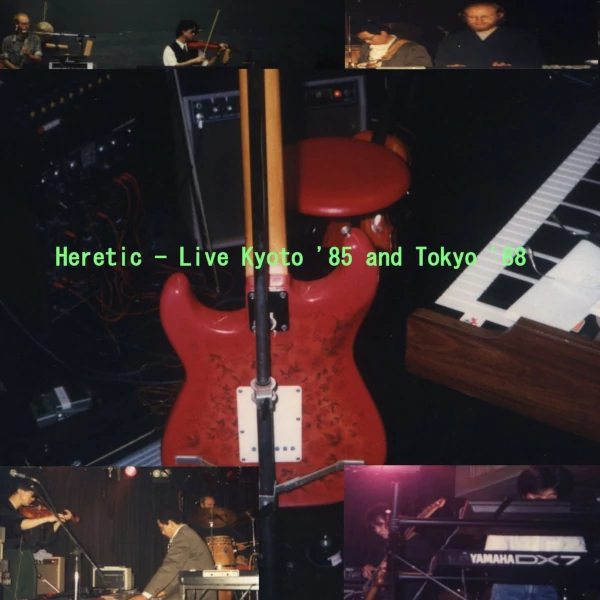 Before we get too far ahead of ourselves, and keeping the discussion together with studio recordings from the same time period, there are well over two hours of never-before-released (in any format) live recordings on the set Heretic Live – Kyoto ‘85 and Tokyo ‘88, remastered in 2022 like everything else in this set. The first track is the set from Ritsumeikan University in Kyoto on November 4, 1985. Nothing is titled here, but it’s a 66 minute improvisation that develops into an extended version of “Do Heretick” fearuring Kawahara on electric guitar, electric violin, guitar-synthesizer, synthesizer, and sampler, Tohru Ohta on synthesizer, guitar synthesizer, electric guitar and elexctronic percussion, and Robbin Lloyd on acoustic percussion, shakuhachi, and keyboards. The original recording of this was the monaural audio accompaniment to a video of the performance, later reimaged and remastered using the latest tools. The two Tokyo ‘88 pieces consist of a 42 minute rehearsal on March 13, and a 28 minute performance on March 19 recorded at Meguro Live Station, the lineup again featuring Kawahara, Ohta, and Lloyd, with Chihiro S (from Lacrymosa) on bass, and Kazuya Takeuchi on sampler and electric guitar. Again, this is a slowly developing improvisation that takes shape over its entire duration, shifting through a number of different portals as it proceeds.
Before we get too far ahead of ourselves, and keeping the discussion together with studio recordings from the same time period, there are well over two hours of never-before-released (in any format) live recordings on the set Heretic Live – Kyoto ‘85 and Tokyo ‘88, remastered in 2022 like everything else in this set. The first track is the set from Ritsumeikan University in Kyoto on November 4, 1985. Nothing is titled here, but it’s a 66 minute improvisation that develops into an extended version of “Do Heretick” fearuring Kawahara on electric guitar, electric violin, guitar-synthesizer, synthesizer, and sampler, Tohru Ohta on synthesizer, guitar synthesizer, electric guitar and elexctronic percussion, and Robbin Lloyd on acoustic percussion, shakuhachi, and keyboards. The original recording of this was the monaural audio accompaniment to a video of the performance, later reimaged and remastered using the latest tools. The two Tokyo ‘88 pieces consist of a 42 minute rehearsal on March 13, and a 28 minute performance on March 19 recorded at Meguro Live Station, the lineup again featuring Kawahara, Ohta, and Lloyd, with Chihiro S (from Lacrymosa) on bass, and Kazuya Takeuchi on sampler and electric guitar. Again, this is a slowly developing improvisation that takes shape over its entire duration, shifting through a number of different portals as it proceeds.
The first Heretic release to receive the compact disc treatment is the compilation disc Heretic 1984-88, a collection of material from the first two LPs. The full length “Do Heretick” from Escape Sequence is here, although it’s a different remaster version (sound is quite different), as is the version of “Fail Safe Error,” here a bit less intense. All of the shorter cuts from the second side are here, although they are different remaster versions, so they do sound different. Two shorter excerpts from “Interface” are here (six-and-a-half minutes from Part 1 and eight-minutes and change from Part 2) as well as a seven minute excerpt from “El Rayo de Luna,” again in very different remastered versions. “Resource” is a nine minute jam from the day after the aforementioned Tokyo performance in 1988 featuring the core trio plus drummer Ichirou Takesako and Chihiro S on bass, the double drums resulting in a powerful free-form groove. Here at Exposé we have already spilled plenty of ink on this superb compilation since it was the very first thing by Heretic that came to our attention. You can read the three reviews we wrote in the printed edition here. Two bonus tracks have been added in this digital edition, one is another excerpt from “Interface Part 2” but taken from a completely different recording in 2008, the other is titled “Hiro Kawahara Variation Parts 1-3” for a total seventeen minutes of added bonus material. The original cover of 1984-88 could not be used due to the unauthorized use of the Escher image on the cover of the original, so an image of the red Stratocaster and some of the studio equipment used in that period took its place.
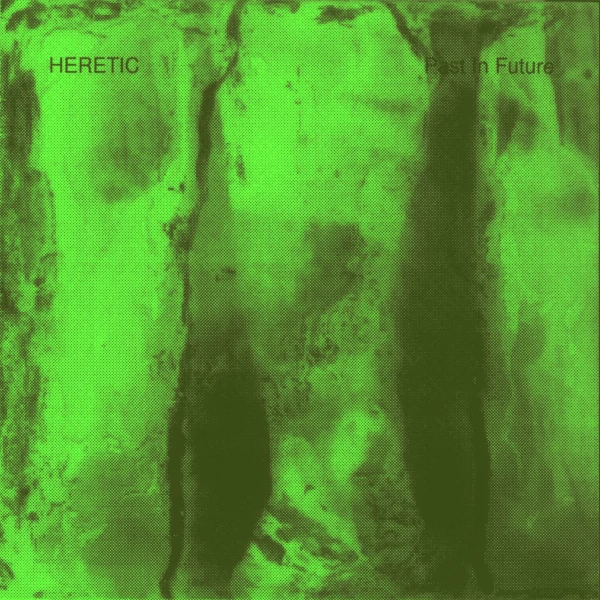 In 1996, Kawahara released two demo pieces of what were planned to be the next two Heretic releases, and released them on a very limited edition single disc Past in Future to raise money for the execution of both projects. While these were Kawahara’s concepts and not fleshed out by the full group yet, they do give a very clear idea as to how the next two pieces “Yayoi Dream” and “Drugging For M” were coming together, the first a mix of experimental and ambient ideas, the second more of a full-on electronic rock like Heldon, both pieces clocking in around thirty-five minutes each, We reviewed this one in our printed edition, issue #10, read it here. One bonus track was added to the original, a sixteen minute and change version of “In The Mist of Time (For Peter Frohmader)” on which Kawahara sampled Frohmader playing bass and synthesizers.
In 1996, Kawahara released two demo pieces of what were planned to be the next two Heretic releases, and released them on a very limited edition single disc Past in Future to raise money for the execution of both projects. While these were Kawahara’s concepts and not fleshed out by the full group yet, they do give a very clear idea as to how the next two pieces “Yayoi Dream” and “Drugging For M” were coming together, the first a mix of experimental and ambient ideas, the second more of a full-on electronic rock like Heldon, both pieces clocking in around thirty-five minutes each, We reviewed this one in our printed edition, issue #10, read it here. One bonus track was added to the original, a sixteen minute and change version of “In The Mist of Time (For Peter Frohmader)” on which Kawahara sampled Frohmader playing bass and synthesizers.
The fully actualized Yayoi Dream appeared later in 1996, a beautiful series of ambient and experimental vignettes that feature a strong Japanese traditional influence at times, the latter mainly due to the shakuhachi and chants that are featired in some of the parts. Around the time that one idea gets moving and grooving, everything suddenly changes and a completely new idea is ushered in. Like going through a portal, each vignette offers something different and unusual, and completely different than the one that preceeded it, each lasting only a minute or two. It was during the final stages of Yayoo Dream development that Exposé featired an interview with Hiro Kawahara to discuss the piece’s ongoing progress, and other works before it and planned for the future. There are no indexes, it’s a single thirty-six and a half minute bloc of music that’s meant to be listened to in its entirety, and probably represents Heretic’s strongest entry in this entire collection. At the time, shortly after its release, Henry Schneider reviewed it and you can read that review here. One bonus track is included after the main event, a one-ninute Kawahara solo piece “For Peter Frohmader,” an ambient piece that compliments Yayoi Dream respectfully.
It wouldn’t be for another year before the release of the fully fleshed out Drugging for M. Like its predecessor, it’s one long-form piece, 34 minutes in length, but a very different animal altogether, with pulsating electrinics and driving grooves in the forefront, yet still with an abundance of regular changes as the piece proceeds, many of the quieter parts offering a very Crimson-like perspective. Another way that it differs is in the lineup: Tohru Ohta does not participate; instead it’s Robbin Lloyd on electronic percussion and Kawahara playing electric guitars, synthesizers, theremin, sampler, and electronics. Also joining are Kohzi Ishii on Chapman stick and Masahiro Noda on electric guitar. Shortly after its release in issue 14, Exposé presented a full three-way roundtable review of Drugging for M, worth taking a look at now for some different thoughts. On this remastered version, one bonus track has been included, “TD-7 with Robbin Lloyd,” a very brisk Heldon-like pulsating electronic piece that’s just shy of three minutes, but nonetheless effective.
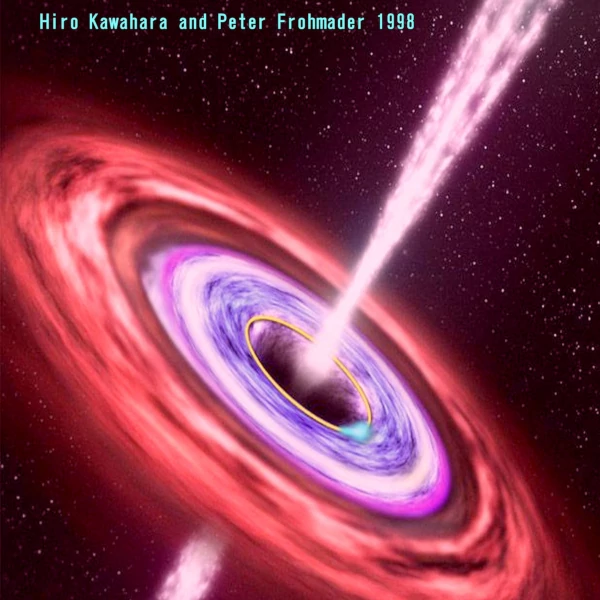 In 1998, Hiro Kawahara and Peter Frohmader agreed to a long-distance collaboration on several tracks that Frohmader had written. At that point Kawahara was still residing in Kyoto, and when he received the pieces from Frohmader he overdubbed his parts in his studio in Kyoto, but as sometimes happens, he got busy with work and as a result ended up moving to Tokyo and essentially retired from making music for a number of years. The overdubbed recordings remained with Kawahara all these years, but last year upon learning of Frohmader’s passing, an effort was made to make these recordings available. Kawahara contacted Steve Feigenbaum at Cuneiform Records, and agreed not only to publish the 1998 recordings Hiro Kawahara and Peter Frohmader, but also the rest of Kawahara’s catalog with Heretic, Osiris, and Astral Tempel, all under review here. The collaborative tracks include two sidelong pieces “The Earth” and “Sphinx Touch,” and two shorter pieces “Virtual Nature” and “9-13,” both in the six-to-seven minute range. In addition, Kawahara included his own piece “In the Mist of Time” (demoed on Past in Future, where Frohmader’s bass parts are sampled), here with 3-D processing remix. Throughout, Fromahder plays bass and synthesizers, and Kawahara added electric guitars, synthesizers, sampled sounds (voices, etc.), and 3-D processing. While no Mellotron is credited, one can hear that sound all throughout “Sphinx Touch” as well as occasionally on other pieces. The sound is pretty much what one familiar with both artists would expect, with Frohmader bringing the dark and pensive imagery and throbbing basses, and Kawahara the experimental chaos and howling guitars, the sampled voices and bird sounds adding a powerful chemistry to the totality of what they accomplished here; “The Earth” is particularly expansive and dreamy, with identifiable milestones as it proceeds forward. Two bonus tracks are included, neither of which features Frohmader; in fact these draw on material from the early 80s project Astral Tempel “Shadow Illusion Vista Under Light” (28 minutes) and “Heretic 1984-1988 Sequence” (22 minutes).
In 1998, Hiro Kawahara and Peter Frohmader agreed to a long-distance collaboration on several tracks that Frohmader had written. At that point Kawahara was still residing in Kyoto, and when he received the pieces from Frohmader he overdubbed his parts in his studio in Kyoto, but as sometimes happens, he got busy with work and as a result ended up moving to Tokyo and essentially retired from making music for a number of years. The overdubbed recordings remained with Kawahara all these years, but last year upon learning of Frohmader’s passing, an effort was made to make these recordings available. Kawahara contacted Steve Feigenbaum at Cuneiform Records, and agreed not only to publish the 1998 recordings Hiro Kawahara and Peter Frohmader, but also the rest of Kawahara’s catalog with Heretic, Osiris, and Astral Tempel, all under review here. The collaborative tracks include two sidelong pieces “The Earth” and “Sphinx Touch,” and two shorter pieces “Virtual Nature” and “9-13,” both in the six-to-seven minute range. In addition, Kawahara included his own piece “In the Mist of Time” (demoed on Past in Future, where Frohmader’s bass parts are sampled), here with 3-D processing remix. Throughout, Fromahder plays bass and synthesizers, and Kawahara added electric guitars, synthesizers, sampled sounds (voices, etc.), and 3-D processing. While no Mellotron is credited, one can hear that sound all throughout “Sphinx Touch” as well as occasionally on other pieces. The sound is pretty much what one familiar with both artists would expect, with Frohmader bringing the dark and pensive imagery and throbbing basses, and Kawahara the experimental chaos and howling guitars, the sampled voices and bird sounds adding a powerful chemistry to the totality of what they accomplished here; “The Earth” is particularly expansive and dreamy, with identifiable milestones as it proceeds forward. Two bonus tracks are included, neither of which features Frohmader; in fact these draw on material from the early 80s project Astral Tempel “Shadow Illusion Vista Under Light” (28 minutes) and “Heretic 1984-1988 Sequence” (22 minutes).
 Requiem: A musical setting for a Mass celebrating the dead. The dead in this case is Heretic, something that, in 2010, Hiro Kawahara knew he wouldn’t be getting back to anytime soon, if ever. But there were still many pieces of music throughout his career that were worthy of hearing that had never been released to a wider audience, so the idea with Requiem was to collect many of these pieces together and release them as a ‘final’ CD by Hiro Kawahara and Heretic. The original 2010 Requiem CD featured only eight tracks, mostly alternate versions or edits of things that had been released previously. With the Cuneiform remastered digital release, the track count has risen to 22, most of the additional tracks coming from the pre-Heretic period in the early 80s, pieces by Osiris (which is in essence solo Kawahara, sometimes with guests, from 1980-81), and Astral Tempel, a trio project of Kawahara’s with Kojima or Maeda on drums, and Okabe or Ohtsuki on bass, that existed between late 1980 and ’82. Most of the Osiris cuts were taken from the Osiris LP In the Mist of Time, while the Astral Tempel cuts appeared on early cassettes and on the 1997 CDr Fragments of Dream. The track order on the 2010 CD of Requiem is very different from the current digital release, which now opens with the expansive twenty minute “Spiral,” a Kawahara solo creation from 1999, a powerful ambient statement with Frippian guitars shooting skyward and many interesting experimental passages. Edited versions of “Drugging for M” and “Yayoi Dream” follow, five minutes and four minutes respectively, perhaps created for radio play. “Variation Part 3” is a short, brightly melodic Kawahara solo piece from 1987, vaguely reminiscent of the work of the late Vangelis. Two more Heretic pieces follow, a 1984 edited version of “Interface” (still approaching 30 minutes) and a 1984 alternate version of “El Rayo de Luna.” Following that are sixteen Osiris and Astral Tempel tracks, most are fairly short vignettes that present a single idea, dometimes beautifully melodic, sometimes ambient, sometimes more experimental, all worthy excerpts of Kawahara’s early oeuvre. Worthy of special note are the twenty minute live Astral Tempel recording from December 1980 “Gate to Infinity / Steppin Roll / Shadow Illusion,” the original Osiris version of “El Rayo de Luna” that clocks in at 22 minutes, and the nine minute proto-industrial piece “Echo Troublant” from 1982. Just some of the highlights of the added tracks.
Requiem: A musical setting for a Mass celebrating the dead. The dead in this case is Heretic, something that, in 2010, Hiro Kawahara knew he wouldn’t be getting back to anytime soon, if ever. But there were still many pieces of music throughout his career that were worthy of hearing that had never been released to a wider audience, so the idea with Requiem was to collect many of these pieces together and release them as a ‘final’ CD by Hiro Kawahara and Heretic. The original 2010 Requiem CD featured only eight tracks, mostly alternate versions or edits of things that had been released previously. With the Cuneiform remastered digital release, the track count has risen to 22, most of the additional tracks coming from the pre-Heretic period in the early 80s, pieces by Osiris (which is in essence solo Kawahara, sometimes with guests, from 1980-81), and Astral Tempel, a trio project of Kawahara’s with Kojima or Maeda on drums, and Okabe or Ohtsuki on bass, that existed between late 1980 and ’82. Most of the Osiris cuts were taken from the Osiris LP In the Mist of Time, while the Astral Tempel cuts appeared on early cassettes and on the 1997 CDr Fragments of Dream. The track order on the 2010 CD of Requiem is very different from the current digital release, which now opens with the expansive twenty minute “Spiral,” a Kawahara solo creation from 1999, a powerful ambient statement with Frippian guitars shooting skyward and many interesting experimental passages. Edited versions of “Drugging for M” and “Yayoi Dream” follow, five minutes and four minutes respectively, perhaps created for radio play. “Variation Part 3” is a short, brightly melodic Kawahara solo piece from 1987, vaguely reminiscent of the work of the late Vangelis. Two more Heretic pieces follow, a 1984 edited version of “Interface” (still approaching 30 minutes) and a 1984 alternate version of “El Rayo de Luna.” Following that are sixteen Osiris and Astral Tempel tracks, most are fairly short vignettes that present a single idea, dometimes beautifully melodic, sometimes ambient, sometimes more experimental, all worthy excerpts of Kawahara’s early oeuvre. Worthy of special note are the twenty minute live Astral Tempel recording from December 1980 “Gate to Infinity / Steppin Roll / Shadow Illusion,” the original Osiris version of “El Rayo de Luna” that clocks in at 22 minutes, and the nine minute proto-industrial piece “Echo Troublant” from 1982. Just some of the highlights of the added tracks.
The Complete Works collection is only 62 tracks, it doesn’t sound like a lot, but but many of them are epic length; certainly it’s a journey of discovery, especially for listeners not familiar with much of the work that has already been released in the past, and the latest remastering makes those even more powerful.
Filed under: Archives, 2023 releases
Related artist(s): Heretic / Hiro Kawahara, Peter Frohmader / Nekropolis
More info
http://cuneiformrecords.bandcamp.com/album/complete-works
What's new
These are the most recent changes made to artists, releases, and articles.
- Listen and discover: They're schizo, they're fun, and they're dreaming
Published 2026-01-02 - Review: Zabrahana - Whales Dream in Purple
Published 2026-01-02 - Review: McLuhan - Anomaly
Published 2026-01-01 - Review: Ektör - Ektöristan
Published 2025-12-31 - Release: Chatte Royal - Mick Torres Plays Too F***ing Loud
Updated 2025-12-30 15:33:15 - Artist: Chatte Royal
Updated 2025-12-30 15:32:15 - Release: Olly Chalk - In Those Remote Stars
Updated 2025-12-30 14:01:10 - Artist: Olly Chalk
Updated 2025-12-30 13:59:56 - Review: Pietro Zollo - The Future Is Now
Published 2025-12-30 - Release: Dhope - Musical Exhibitions
Updated 2025-12-29 23:00:53 - Release: Tin Pan Alley - Tin Pan Alley
Updated 2025-12-29 22:51:10 - Release: Jeff Pearce - Infinite Ambient: Winter Landscapes
Updated 2025-12-29 22:33:12 - Release: Trio of Bloom - Trio of Bloom
Updated 2025-12-29 17:19:40 - Artist: Trio of Bloom
Updated 2025-12-29 17:16:50 - Artist: Craig Taborn
Updated 2025-12-29 17:02:15 - Release: Family - Old Songs, New Songs
Updated 2025-12-29 00:03:41 - Review: The Kirkbys - It's a Crime: The Complete Recordings
Published 2025-12-29 - Release: Various Artists - Psychedelic Underground 20
Updated 2025-12-28 23:33:26 - Artist: Dhope
Updated 2025-12-28 23:27:49 - Artist: Tin Pan Alley
Updated 2025-12-28 23:21:39
